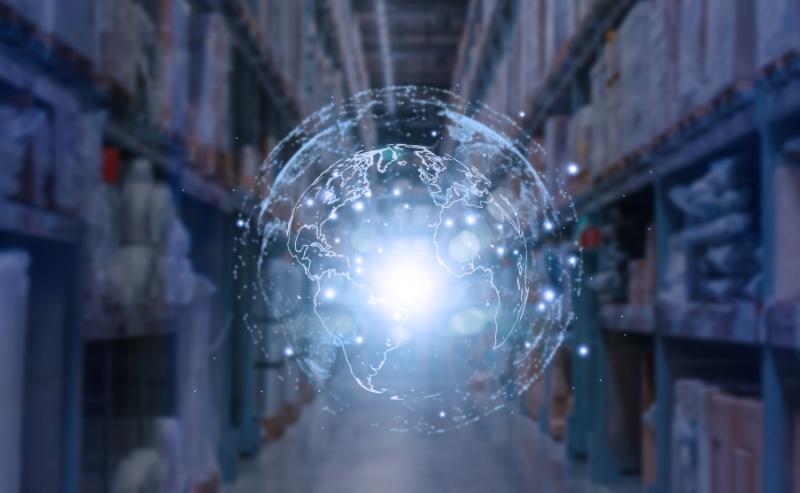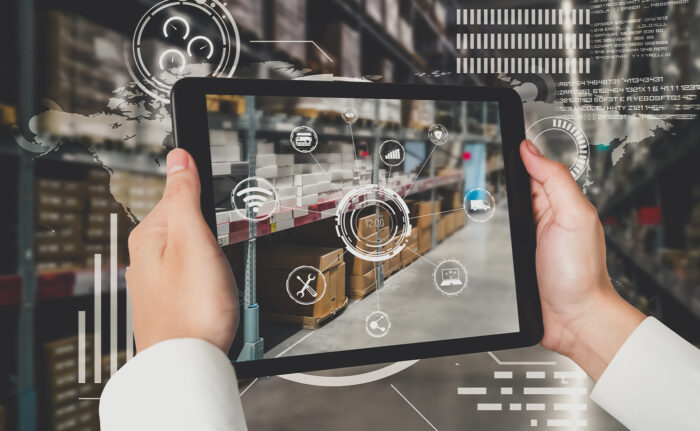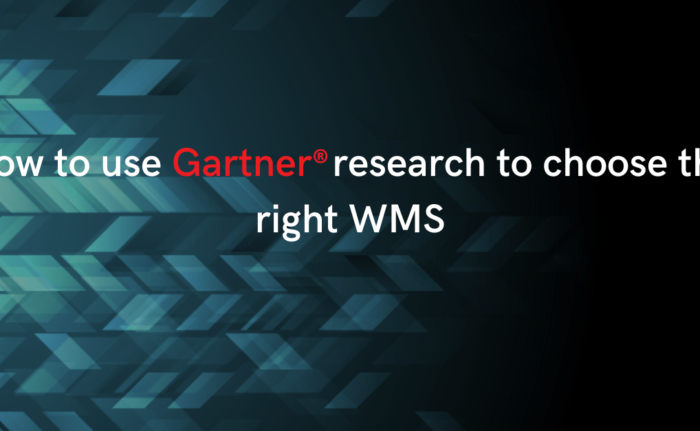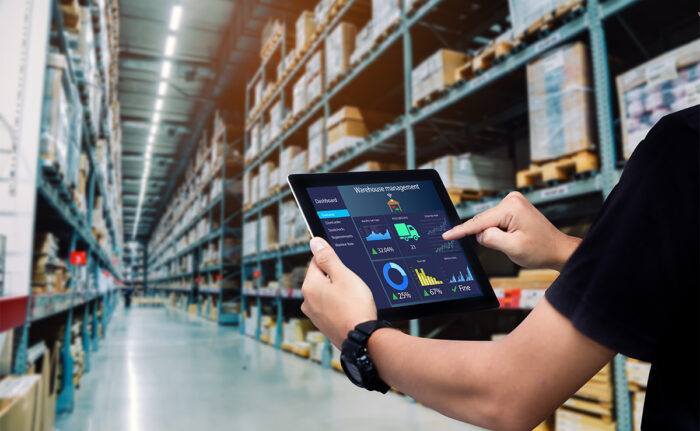
While warehouse management systems (WMSs) have revolutionized warehouse efficiency, the future of warehouse management is increasingly being shaped by Artificial Intelligence (AI). AI-driven solutions go beyond streamlining daily operations—they are transforming inventory management, automation, and decision-making, enabling warehouses to achieve new levels of efficiency and accuracy.
There are a variety of AI solutions that can be harnessed to improve operational efficiency. In this article, we’ll cover what you need to know about AI in the warehouse, including:
- How AI is Used in Warehouses
- How is AI used in warehouse management?
- How is AI used in inventory management?
- How is AI used in logistics management?
- Powerful Benefits of AI in Warehouse Management
- Top 3 Applications of AI in Warehouse Management
How AI is Used in Warehouses
There are multiple ways to use AI in warehouses to help improve efficiency, accuracy, and adaptability. It can be used in warehouses through a combination of WMS, Internet of Things (IoT) devices, robotics, and advanced analytics platforms. While AI can be both standalone and integrated, it’s typically integrated into existing systems or operates as an overlay technology that enhances warehouse operations. Its main uses can be divided into three major categories, warehouse management, inventory management, and logistics management.
How is AI used in warehouse management?
AI is transforming warehouse operations by streamlining workflows, optimizing resource usage, and enhancing decision-making in real time. Here’s how:
- Task Prioritization & Labor Optimization: AI dynamically assigns tasks to workers or robots based on real-time inventory levels, order priorities, and worker availability—maximizing throughput and reducing idle time.
- Intelligent Robotics & Automation: Robots equipped with AI and vision systems can pick, pack, and transport items with precision—reducing human error and boosting productivity.
- Predictive Maintenance: AI analyzes equipment usage and sensor data to predict when systems (like conveyors or forklifts) need maintenance—avoiding downtime and improving safety.
- Dynamic Slotting: AI continuously analyzes movement data to recommend better storage locations—minimizing travel time and improving pick efficiency.
- Visual Inspection & Quality Control: AI-powered vision systems inspect items for damage or errors during receiving, picking, or packing, improving accuracy and customer satisfaction.
How is AI used in inventory management?
While warehouse AI focuses on optimizing movement and operations, AI in inventory management ensures that the right products are available at the right time and place. Here’s how:
- Demand Forecasting & Planning: AI predicts future inventory needs based on historical data, market trends, and real-time sales—reducing overstocks and stockouts.
- Automated Replenishment: Smart systems trigger replenishment orders based on actual consumption and predictive models—keeping inventory levels balanced without manual oversight.
- Inventory Optimization Across Locations: AI analyzes data across warehouses, stores, and channels to rebalance inventory and meet demand efficiently.
- Anomaly Detection: AI flags irregularities in stock movement, shrinkage, or miscounts—boosting inventory accuracy and reducing loss.
- Real-Time Visibility with IoT + AI: AI interprets real-time sensor data to provide visibility into location, temperature, or condition of inventory—critical for perishables and high-value goods.
- Scenario Planning & Risk Mitigation: AI runs simulations to test how demand spikes, supplier delays, or disruptions would affect inventory, helping teams stay agile and prepared.
How is AI used in logistics management?
AI in logistics management connects the dots between systems, carriers, and customers, turning your transportation network into a responsive, intelligent, and resilient engine. Here’s how:
- Route Optimization & Dynamic Rerouting: AI analyzes real-time traffic, weather, delivery windows, and historical patterns to determine the most efficient routes. If conditions change, it can instantly reroute drivers to minimize delays and fuel usage.
- Predictive Delivery & ETA Accuracy: AI models can accurately predict estimated time of arrival (ETA) for shipments by factoring in everything from driver behavior to road conditions — improving customer satisfaction and logistics planning.
- Freight Pricing & Load Optimization: AI helps optimize loads and select the most cost-effective carrier based on capacity, fuel costs, historical rates, and shipment urgency—maximizing margins and reducing waste.
- Shipment Tracking & Exception Management: AI monitors in-transit shipments across multiple carriers, flagging anomalies like delays or damages. It can then trigger automated workflows (alerts, re-routing, or escalations) to proactively resolve issues.
- Demand-Sensitive Carrier Selection: AI dynamically selects the best carrier or mode (truck, rail, air, etc.) based on service levels, capacity constraints, demand spikes, or seasonal factors—balancing cost and speed.
- Supply Chain Risk Prediction: From political instability to port congestion or supplier disruptions, AI continuously scans global data to forecast potential risks and recommend alternative paths or suppliers before issues arise.
- Carbon Emissions Tracking & Sustainability Planning: AI helps logistics teams calculate and reduce their carbon footprint by simulating different transportation methods and routes, supporting ESG goals and reporting.
Powerful Benefits of AI in Warehouse Management
When it comes to the warehouse, AI is no longer a futuristic concept—it’s actively transforming operations, optimizing workflows, increasing productivity, and cutting costs. Benefits include:
- Enhanced Decision-Making: By analyzing vast amounts of data in real-time, managers can make informed decisions faster, whether it be about route optimization or staffing levels.
- Improved Efficiency: Automation solutions and AI-driven automation reduces the need for manual labor, helping warehouses increase operational speed while reducing the risk of human error. Some automation solutions empower robots and humans to work together, further increasing efficiency and maximizing throughput and accuracy.
- Cost Reduction: AI helps to reduce labor costs and errors that can lead to costly delays by automating tasks like inventory management and order picking.
- Scalability: AI-powered solutions are scalable, meaning warehouses can grow without sacrificing efficiency. As businesses expand, AI tools help manage the increased complexity with ease.
- Increased Accuracy: AI-powered systems continuously track and analyze warehouse processes, enhancing accuracy in inventory management, order picking, and route planning. By leveraging real-time data, these technologies minimize human error and optimize overall operational performance.
With AI, warehouses can achieve higher levels of productivity, safety, and customer satisfaction, positioning themselves competitively in the evolving logistics landscape.
Top 3 Applications of AI in Warehouse Management
As warehouses evolve to meet increasing demand and complexity, AI is becoming a mission-critical asset. While artificial intelligence can support a wide range of tasks, three applications stand out as highly transformative for warehouse performance and productivity.
#1 AI-Powered Vision Technology
AI-powered vision systems are revolutionizing visibility and quality control on the warehouse floor. Using advanced cameras, sensors, and machine learning algorithms, these systems can identify products, scan barcodes, detect damages, verify labels, and even monitor worker safety in real time.
Whether it’s for automated inspection, inventory counting, or dynamic slotting, AI vision enables warehouses to operate with greater accuracy, speed, and confidence—minimizing errors and maximizing uptime.
#2 Intelligent Robots & Cobots
Today’s warehouse robots aren’t just lifting and moving—they’re thinking. With embedded AI capabilities, autonomous mobile robots (AMRs) and collaborative robots (cobots) can interpret their surroundings, make real-time decisions, and adapt to dynamic workflows.
From navigating tight aisles and avoiding obstacles to optimizing picking paths and responding to live orders, these intelligent machines are increasing productivity while reducing human strain. AI also enables robots to learn and improve over time, continuously refining their performance with every task completed.
#3 AI-Driven Workforce Optimization
Labor remains one of the most critical and costly components of warehouse operations. AI is now helping to optimize workforce planning by forecasting labor needs based on order volume trends, peak season patterns, and SKU movement.
These tools can dynamically assign tasks, balance workloads, and even recommend shift adjustments to avoid bottlenecks and burnout. Combined with real-time labor tracking and predictive analytics, AI-powered labor management enables more agile, cost-effective staffing strategies that align perfectly with operational demand.
What’s next for AI in warehouse management?
So, what does the future of AI in warehouse management look like? Made4net recently joined forces with Flymingo and Locus Robotics to present: Empowering Warehouse Excellence with Artificial Intelligence. During the session, we explored how AI is reshaping roles, improving efficiency, and setting the stage for the next generation of supply chain operations. You can learn more and watch the full session here.


